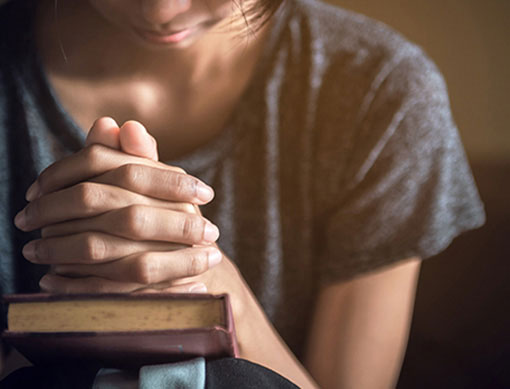Jesus has taught us the perfect way to pray in the Lord’s Prayer, found in similar forms in the Gospels of Luke (Ch. 11) and Matthew (Ch. 6). The disciples could see that prayer was an important part of his life. They must have noticed something about the way he prayed that was different. It made them want to learn how to pray as he did. Luke tells us that Jesus was “full of joy through the Holy Spirit” when he prayed. (Luke 10:21a). Prayer refreshed and renewed him.
 Saint Augustine (A.D. 354-430) described the Lord’s Prayer this way: “Run through the words of the holy prayers [in Scripture], and I do not think that you will find anything in them that is not contained in the Lord’s Prayer.” We pray this prayer at every Mass. It is the tradition of the Church to pray the Lord’s Prayer three times a day. Think about when you could add the Lord’s Prayer one extra time during the school day with your students.
Saint Augustine (A.D. 354-430) described the Lord’s Prayer this way: “Run through the words of the holy prayers [in Scripture], and I do not think that you will find anything in them that is not contained in the Lord’s Prayer.” We pray this prayer at every Mass. It is the tradition of the Church to pray the Lord’s Prayer three times a day. Think about when you could add the Lord’s Prayer one extra time during the school day with your students.
The Lord’s Prayer illustrates the order in which we should pray: Praise; Petition; Sorrow; Reliance of God totally. If we do this, our relationship with God will be in right order and so will your priorities. Your Blest Are We Faith in Action revisits the Lord’s prayer in every grade. Look in the Table of Contents in your Teacher Edition for more ways to teach and pray the Lord’s Prayer.
We Examine Our Actions. Reflecting on the Lord’s Prayer is especially appropriate when your students are preparing to go to Confession. It has all the various kinds of prayer in one: God’s name is glorified, his plans for creation be fulfilled, we realize how God cares for us and gives us what we need, our daily bread and forgiveness of our sins. We pledge to forgive others, confident that God will defend us from harm.
From Trespasses to Treats. After praying the Lord’s Prayer, ask students to name some ways that someone might trespass against another person. After making a list of their ideas, ask students for ways they would want to be treated instead. For example: A trespass could be excluding someone from a game; the treat could be to invite them to play. Another example, a gossiping about someone is a trespass; it would be a treat to say what you like about the person.
Putting Prayer in Motion. We can pray with our bodies as well as our voices. For example, we genuflect silently to offer God praise. We make a Sign of the Cross. Invite students to act out the Lord’s Prayer. Ask students, “If you wanted to pray the Our Father without using words, how would you dramatize “heaven,” “daily bread,” "forgiving,” or “deliver us”? You could even add music to the prayer demonstration.
Explore more ideas for classroom prayer in the free Catholic Resources.
Product highlights:
- Catholic Prayers and Practices for Young Disciples (English)
- Catholic Prayers and Practices (English)
- Our Family Prays - Catholic Prayers & Traditions (English)
 About the Author
About the AuthorDr. Lauri Przybysz specializes in equipping families to live their vocation to be domestic churches and signs of God’s love. Lauri received the Doctor of Ministry from the Catholic University of America, and she has been both a Catholic middle school religion teacher and a faith formation coordinator at the archdiocesan and parish levels. She is the mother of six children and grandmother of 21.
